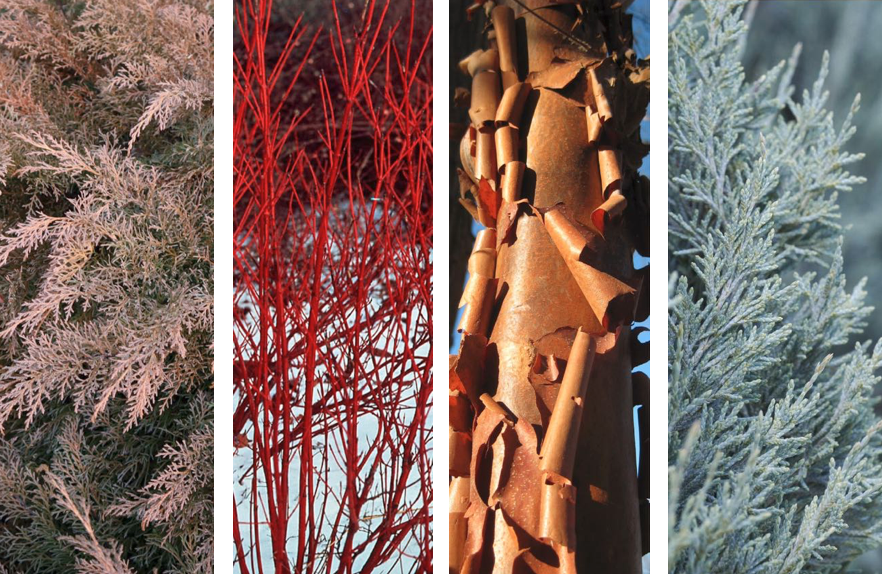Winter Interest
Here in the Midwest it’s easy to dismiss the idea of color or showiness in the landscape during the long winter months. The weather draws us inside to warm and cozy. Evidences of life out of doors present a challenge to witness. But gems shine even now. We’ve put together a line-up of some winter interest plant staples as well as some less-known species.
We often describe evergreens as the ‘bones’ in a landscape. They provide structure all year round. A combination of their woody framework and foliage producing the valued effect in our winter landscapes. Two shrubs in particular bring unique qualities I like to include in my designs often. Siberian Cypress, Microbiota decussata, is an evergreen conifer. It is low growing reaching a height of only 12 to 18 inches, but it spreads to as much as 10 to 12 feet! During the winter its earlier bright green garb turns bronze-purple. I love to pair it as a groundcover near other broadleaf evergreens for a sharp contrast. Another evergreen I like to use is Wichita Blue Juniper, Juniperus scopulorum ‘Wichita Blue’. This small tree fits beautifully in smaller residential spaces where you want some vertical accent. It grows to a height of 10 to 15 feet with a relatively slender habit of four to six feet wide. Aside from its friendly size, it brings a silvery blue hue to the landscape. Effectively providing depth and dimension to the color spectrum of the winter-scape.
Deciduous trees tend to stand in the spotlight in the growing season, but there are many that can garner our attention in the winter too. The Japanese Stewartia, Stewartia pseudocamellia, is a multi-stemmed, small flowering tree with a pyramidal to oval-shaped habit. Typically reaching between 20 to 40 feet tall with a spread of 15 to 30 feet wide. It blooms white, camellia-like flowers in early summer with a reddish-orange to burgundy autumnal color show. As if that weren’t enough, it prances into winter showing off its exfoliating, reddish-brown bark. The colors overlap like fish scales providing quite the mosaic display. Another tree with exfoliating bark is the Paperbark Maple, Acer griseum. Its cinnamon bark looks like post it notes stuck to branches. This tree grows 20 to 30 tall with a spread of 15 to 25 feet wide making it another good fit for smaller residential sites.
Probably some of the most well-known winter interest plants are the Redtwig Dogwood, Cornus alba ‘Sibirica’, and Winterberry, Ilex verticillata. We often see cuttings from these shrubs in holiday planter pots, wreaths, and garlands. In the landscape, Redtwig Dogwood brings bright red contrast against the snow. Combining it with an evergreen backdrop will also help it stand out. Similarly, Winterberry shows off against the snow. If bird-watching brings you joy, plant it near a window for viewing as birds do feed on the berries (eastern bluebirds, wood thrushes, American robins, northern mockingbirds and white-tailed sparrows to name a few).
So far we’ve talked about foliage, bark, and fruit for winter interest. Our topic would not be complete without sharing some species that flower in the winter. One of my favorite perennials is Hellebore, Helleborus. Depending on the species or hybrid, this evergreen perennial blooms from late November through the winter until spring. Bloom colors range from creamy white to vibrant pinks and deep scarlet to burgundy. This plant prefers shady locations in your garden and tends to be avoided by browsing deer. In February and March, Winter Aconite, Eranthis hyemalis, brings us yellow buttercup-like flowers. It is low growing reaching only 3 to 6 inches tall. This perennial goes dormant by late spring/early summer so consider planting it in combination with other perennials that bloom later for continued display.
Hopefully something in this line-up sparks your interest and deems worthy to incorporate into your own garden space. This really only barely scratches the surface of the possibilities. But what better time than winter to plan ahead?
“Anyone who thinks gardening begins in the spring and ends in the fall is missing the best part of the whole year; for gardening begins in January with a dream” (Josephine Neuse).





